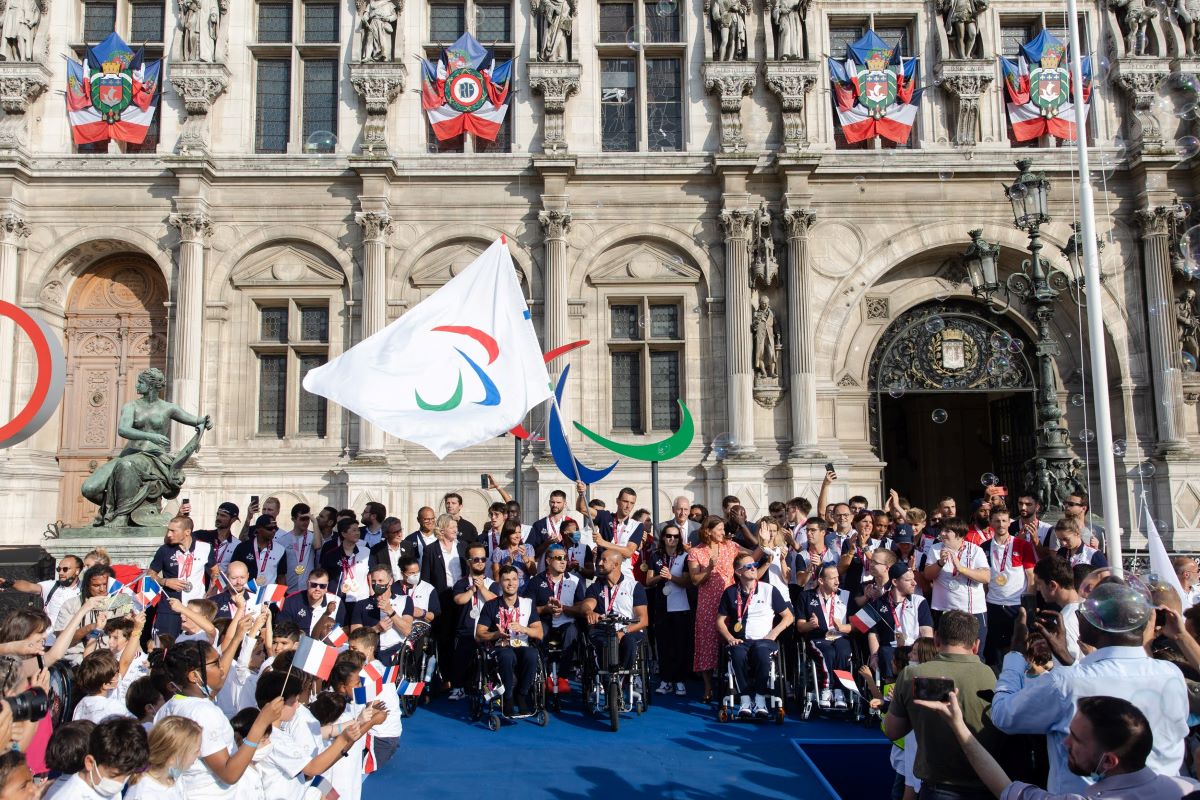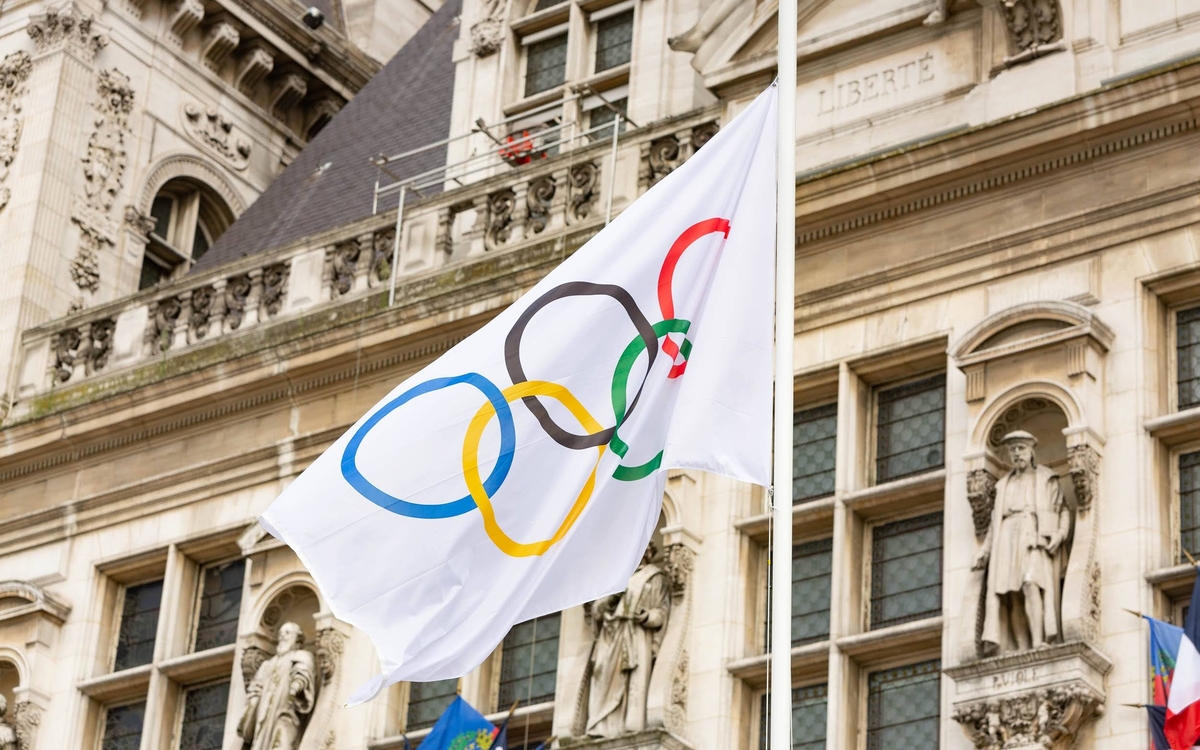Content
Cette page est aussi disponible en français
Before being hoisted up at the Trocadéro, the Olympic flag was flown in front of Paris City Hall since August 9, 2021. Who created it and what does it represent? And what does the Paralympic flag, also present in Paris, look like? We take a look back at the origins of these emblematic symbols of the Games.
Pierre de Coubertin's original letter and sketch
Pierre de Coubertin, the man who brought the Olympic Games back to life, designed this flag in 1913. It's a modern creation that has nothing to do with any ancient design.
The Olympic rings first appeared in 1913 on the letterhead of a letter written by Pierre de Coubertin, drawn and colored in his own hand. The letter, dated July 15, was addressed to Baron Godefroy de Blonay, a Swiss member of the International Olympic Committee (IOC). A second sketch of the rings appears in a letter dated August 6, 1913.

This letter from Pierre de Coubertin to Godefroy de Blonay is one of the first in the IOC's historical archives to feature Coubertin's hand-drawn Olympic symbol. Presence of a second design of the rings drawn in pencil.
Crédit photo :
Comité international olympique
But it seems that the origin of the five rings lies in the emblem of the Union des sociétés françaises de sports athlétiques (USFSA), a French multi-sport federation. In 1890, Pierre de Coubertin, the federation's general secretary, came up with his logo: two interlaced rings, one blue and one red on a white background, the colors of the French flag, accompanied by the Latin inscription " Ludus pro Patria " (Games for the Fatherland).
The Olympic flag has 7 official versions
Coubertin officially presented the flag in 1914."The flag was presented by its author - Pierre de Coubertin - during the 17th IOC Session held at the Sorbonne in 1914 on the occasion of the Olympic Congress commemorating the 20th anniversary of the re-establishment of the Olympic Games and the creation of the International Olympic Committee on June 23, 1894," details the French National Olympic and Sports Committee.
In 1957, the IOC officialized a special version of the rings, varying only slightly from Coubertin's original in the way they intersect. Then, in 1986, interstices were added to the ring intersections to enable them to be reproduced as accurately as possible using the printing techniques of the time.
Finally, in 2010, the official version of the Olympic rings returned to the original model of interlaced rings, with no interstices at the intersections, as imagined by Coubertin.
Today, there are seven official versions of the Olympic rings. The polychrome version on a white background is the most common.
At least one of the five colors is present in every flag in the world

Olympic rings at the Trocadero
Crédit photo :
Jean-Baptiste Gurliat / Ville de Paris
The five interlaced rings represent the five continents united by Olympism (North and South America are represented as one). As for the six colors (including the white in the background), they represent all of the world's nations. At least one of these colors was present in every country's flag when the flag was created. The flag symbolizes the universality of the Olympic spirit.
The motto Citius, Altius, Fortius, a Latin expression meaning "faster, higher, stronger", also appeared on the original Olympic flag. It was a close friend of Pierre de Coubertin, the Dominican Father Henri Martin Didon (1840 - 1900), prior of the Albert-le-Grand school in Arcueil, who came up with this motto.
A flag inaugurated at the 1920 Antwerp Games

First appearance of the Olympic flag at the Antwerp Games in 1920.
Crédit photo :
Comité international olympique
The 1916 Olympic Games, scheduled for Berlin, Germany, were cancelled due to the First World War. It was therefore in 1920, at the Games in Antwerp (Belgium), that the Olympic flag flew for the first time.
It remained in the Olympic stadium until the last day of the Games on September 12, 1920, "during a closing ceremony punctuated by a speech by Pierre de Coubertin and a cantata performed by 1,200 choristers and musicians". The Olympic flag was then handed over to Paris, which would host the Games in 1924. The Olympic visual identity was born!
A flag flying from start to finish
The flag enters the stadium during the opening ceremony of the Olympic Games. It is carried horizontally by athletes, then hoisted onto a flagpole.
Like the Olympic flame, which burns throughout the Games, the flag flies in the stadium from the Opening Ceremony to the Closing Ceremony. During the closing ceremony, it is lowered and handed over to the mayor of the city organizing the next Games.
The arrival of the flag in Paris marks the new Olympiad

The arrival of the flag at the Trocadero on August 9, 2021.
Crédit photo :
Jean-Baptiste Gurliat / Ville de Paris
The Olympic flag was handed over by the Governor of Tokyo, Yuriko Koike, to the Mayor of Paris, Anne Hidalgo, at the closing ceremony of the Tokyo Games on August 8, 2021. It then arrived in the French capital on August 9, marking the start of the new Olympiad, in anticipation of the Paris 2024 Olympic and Paralympic Games!
The Paralympic Games also have their own flag

The Paralympic flag arrives in Paris
Crédit photo :
Jean-Baptiste Gurliat / Ville de Paris
The Paralympic flag was handed over to the Mayor of Paris on September 5, 2021 at the close of the Tokyo Paralympic Games. It arrived in the French capital on September 6!
The flag features the current Paralympic symbol on a white background. It's made up of three "agitos" (which in Latin means "I'm on the move"), red, blue and green respectively, encircling each other on a white background. Each "agito" symbolizes movement, forming together a figure resembling a crescent. Officially approved in April 2003, it was slightly modified in 2019.
Paralympic emblems, since the organization of the first Paralympic Games in Rome in 1960 (also known as the 9th Stoke Mandeville International Games) have often been different from those used for the Olympic Games. But for Paris 2024, the Olympic and Paralympic emblems are identical with the exception of the associated symbol: rings for the former and "agitos" for the latter.

Logos of the Paris 2024 Olympic and Paralympic Games
Crédit photo :
Paris 2024
All the latest news on the Paris 2024 Games
Activities, festivities, disruptions… Get the information you need about the Olympic and Paralympic Games with "Paris Info Jeux 2024!"
We want to hear from you!
Was this information useful to you?
Please note: we cannot reply via this form (please do not include any personal information).


